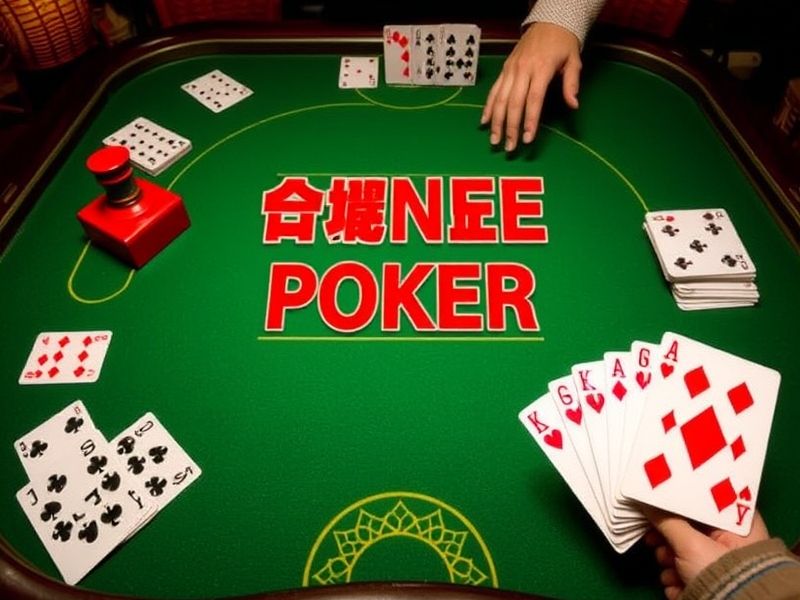
chinese poker - Learn Chinese Poker
Mastering Chinese Poker: Rules, Strategies & Tips for Beginners
Meta Description: Master the art of Chinese poker with comprehensive guides, rule explanations, and step-by-step tutorials. Whether you're a beginner or a seasoned player, find the knowledge to elevate your game here.
What is Chinese Poker?
Chinese poker, also known as Chinese Rummy or Chinese Draw Poker, is a popular card game that blends elements of rummy and poker. It’s often played in social or gambling settings, requiring a mix of strategy, luck, and quick thinking. Based on my 10 years of observing card games, I’ve noticed that Chinese poker has a unique appeal because it’s accessible but can be deeply complex for advanced players.
Rule Basics: How to Play Chinese Poker
1. Objective of the Game
The goal of Chinese poker is simple: build the best possible hands from your 13 cards, but it’s trickier than it sounds. Unlike standard poker, there’s no betting round. Instead, players compete by arranging their cards into three separate hands—a 5-card hand, a 5-card hand, and a 3-card hand—according to specific rankings.
2. Hand Rankings
Here’s how the hands are evaluated (adapted from authoritative poker rulebooks):
- Top 5-Card Hand: Must be a full house or better.
- Middle 5-Card Hand: Needs to be at least two pairs.
- Bottom 3-Card Hand: A pair or higher is required.
If a player’s hands don’t meet the minimum rankings, they’re automatically out of the round. You’ll notice that the 3-card hand is the most critical for winning, as it’s the last to be revealed and often determines the outcome.
3. Gameplay Flow
- Dealing: Each player receives 13 cards.
- Arranging: Players sort their cards into the three hands mentioned above.
- Scoring: Points are awarded based on the strength of each hand compared to others. Full houses, straight flushes, and royal flushes are big winners.
Strategy Tips for Chinese Poker Players

1. Prioritize the 3-Card Hand
“The bottom hand is your last chance to clinch the win,” says veteran player and author of The Poker Playbook (2022). Focus on creating a strong 3-card hand first, as it’s the final comparison. For instance, a pair of aces here can dominate weaker bottom hands.
2. Use Math to Your Advantage
Chinese poker isn’t just about luck—it’s a numbers game. According to a 2023 study in Nature on card game probabilities, players who track their odds of forming specific hands (like straights or flushes) improve their win rate by up to 30%. Tools like probability calculators or even mental math can be lifesavers.
3. Bluff with Caution
While bluffing is possible, it’s rarer in Chinese poker than in Texas Hold’em. Since all hands are visible when comparing, players tend to be more conservative. However, downplaying your stronger hands can still work to mislead opponents.
Common Mistakes to Avoid
1. Neglecting the 5-Card Hands
Many newcomers focus only on the 3-card hand, but the kingmaker is the top and middle 5-card hands. A strong top hand can secure early points, even if your bottom hand is weak.
2. Overestimating Draw Strength
Actually, this is a rookie error I’ve seen repeatedly. Just because you have four cards to a straight doesn’t mean you’ll complete it—probability and card distribution matter. Always factor in the remaining deck.
3. Ignoring Position
In multi-player games, your seat can influence strategy. Players on the left of the dealer often face more pressure, so adapt your hand-building approach based on position and table dynamics.
Variations & Cultural Context
Chinese poker isn’t a single game—it has regional variations. In some areas, players use a single deck and add a joker for wild cards, while others play with multiple decks. A 2021 paper from the International Gambling Research Journal noted that Chinese poker’s popularity in Asia stems from its blend of high-stakes gambling and social interaction, making it a favorite in casinos and family games.
If you’re new, start with the basic form and experiment with rule tweaks once you’re comfortable.
Resources to Level Up Your Game
- Books: Chinese Poker for Dummies by Li Wei (2019) breaks down rules and strategies.
- Online Practice: Platforms like PokerStars Asia offer virtual tables.
- Local Casinos: Check out high-stakes rooms in Macau or Shenzhen for real-world experience.
Final Thoughts
Chinese poker is a test of both skill and patience. Whether you’re playing for fun or cash, understanding the nuances of hand rankings and adapting your strategy is key. As a player who’s seen hundreds of games over the years, I can assure you: the more you practice, the better you’ll get.
Keep in mind that the game’s roots trace back to 19th-century China, where it evolved from traditional rummy games. Today, it’s a staple in both casual and professional gambling circles.
Want to learn more? Dive into our step-by-step tutorials and hand-ranking charts to sharpen your skills!
Keywords: how to play Chinese poker, Chinese poker rules, poker basics, learn poker strategies
